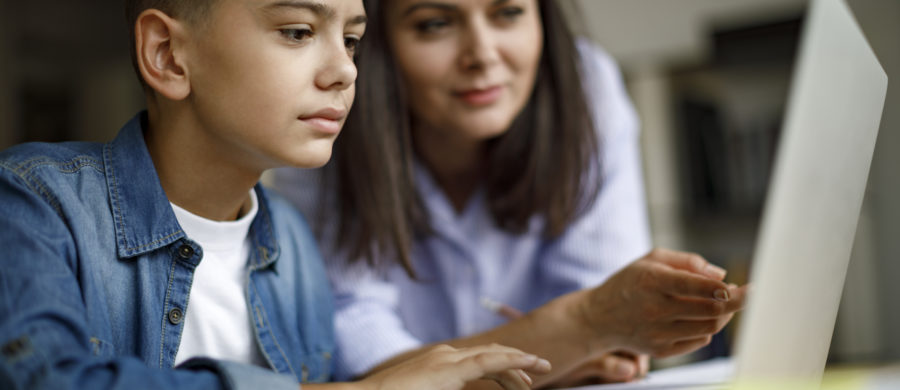Counseling families on media use has always been a part of my wellness visits, but the pandemic has made this a tricky conversation. The American Academy of Pediatrics recommends keeping screen time to less than two hours per day. How does one counsel these guidelines when children need to be on a screen for four to six hours or more per day for their education? There is certainly no way around this, as the benefits outweigh the risks for now.
In light of this, I have pivoted my discussion from screen time to screen content. As a parent, I have found regulation of my kids’ screen content increasingly tricky as they get older. Keeping track of what they are seeing, understanding the technology and how to add filters, and regulating their use has felt like a full-time job. With kids being forced to be online for school and using screens more than ever to maintain their interpersonal relationships, monitoring what they see is harder than ever. I have found it almost impossible to block harmful content even in games that are seemingly safe and geared towards younger children.
I found my daughter asking for things like Snapchat and Instagram, starting at age nine. We thought we were savvy parents and, of course, told her she wasn’t allowed to use social media.
~ Lauren Brave, MD
Take YouTube Kids and Roblox, for example. I know many parents let their younger children watch YouTube Kids. Even the platform’s suggestions are not always appropriate for more minor children, and targeted advertisements can be similarly not age-appropriate. My eight-year-old son loves to play Roblox with his friends, and this app is also targeted towards younger kids. Unfortunately, it has a public chat function that predators could easily use to contact unsuspecting children. It wasn’t until many months after giving my son permission to play Roblox that I discovered this.
As kids get older, the dangers of media increase exponentially. Social media is targeting children at younger ages. I found my daughter asking for things like Snapchat and Instagram, starting at age nine. We thought we were savvy parents and, of course, told her she wasn’t allowed to use social media.
Around that time, she persuaded us to download an app called Musical.ly so she could make cute videos of our pets with filters and music. However, as you may recall, that app turned into TikTok, and suddenly, our daughter had access to a social media platform. At first, this seemed benign as she convinced us that she was only watching art tutorials and dance videos and posting pictures of our pets. Naively and against our better judgment, we didn’t delete the app and trusted that she was telling the truth. As the pandemic hit and she started spending more time on her screens, we eventually discovered that much of her viewing was not benign at all. This took months to figure out.
Most of what kids watch online is not discoverable or recoverable. It flashes before their eyes, impacts them, and then disappears. In one instance, though, I found a particular TikTok video that had been saved on my daughter’s device and asked what she understood about it. She was unable to answer articulately. The video was of a girl who was noticeably depressed and suicidal.
Negative Health Consequences
Studies have clearly shown that social media use has many negative health consequences in children, including a dramatic increase in their tendency towards depression and anxiety. Since the inception of social media, trends in suicide have increased alarmingly in all pediatric age groups. Kids often use screens late at night, disrupting sleep patterns, including falling asleep and staying asleep. Physical inactivity due to screen use has increased the incidence of childhood obesity. Overuse of media has implications for childhood development as a whole.
The addictive quality of our screens is quite clear. There is nothing different between social media use and drug addiction. Social media companies like Facebook and Twitter certainly understand neuropsychology, and their platforms are designed to keep us scrolling. Using social media changes our brains, but it is harder to see this correlation because the action is more subtle and less intrusive. Also, since we are all – and I include myself in this statement – participating in this evolution of our world, it is difficult to stop our children from participating in something that we do not want to quit ourselves. This is a problem.
Parent Strategies
I highly recommend watching the movie Social Dilemma, which does a good job expressing the dangers of social media on our children, ourselves, and society. It also offers simple suggestions on managing technology to make it safer, most of which I found pretty helpful and practical.
As a pediatrician and parent, I have developed valuable strategies for tackling the challenge of social media within the home. When discussing this topic with families, I recommend several tactics, depending on the kids’ age.
For parents of younger kids, I encourage them to avoid social media use for as long as possible. When kids don’t know what they’re missing, it’s easier to keep them from it! Parents often feel pressured to allow their kids to use various apps, mainly because friends may already use them. Please do not feel guilty about banning social media until they are old enough to understand the danger that it presents.
I do not think media use is entirely wrong, as it is undoubtedly part of our world that we need to learn to live with. I would thoroughly vet what your children use to ensure educational value and no way to chat with anonymous users. I would also check to be sure there are no suggestions to click on and no targeted advertising. I would enforce screen limits and set your devices to turn off after a short period.
Older kids pose a different challenge. Almost all have already been exposed to social media and are involved in some way. My advice is to have a very candid conversation with your older kids. Ensure they are only conversing with friends and not anonymous users and understand how predators target them. Discuss the “like” button’s currency, as this can have a terrible effect on their sense of self. Make sure there is no way for them to use their devices after a particular hour, as this can disrupt their sleep cycles – this is critical.
Make sure your kids understand the nature of data on the internet. Posting something today might be discoverable forever and could have implications in their future, such as getting a job. Watch your children for concerning mental health signs such as an increase in depression. When kids withdraw from their usual daily living, seem less interested in activities, are not sleeping well, have a change in appetite, or cannot focus on schoolwork, it’s time to bring these issues to a medical professional’s attention.
I certainly don’t have all the answers to what we should be doing to protect our children – and ourselves – from social media. It is evolving at a rapid rate, and there is zero regulation. This is an adult world in which kids are actively participating. It’s as if we have let them into a casino and said, “have fun!”.
It is no surprise that social media use is causing problems for our kids. A safe space needs to be created for them within the online world. Unfortunately, social media is in the hands of companies that have no financial incentive to do so. These companies are profiting from the children running amok. I’m afraid, at the moment, we are all trapped here together.
Practically speaking, it seems impossible to avoid altogether interacting with the online world despite this being dangerous and damaging. As a parent, I have had some massive failures in protecting my children. I still don’t know if I’m making the right choices some of the time. I am just encouraging everyone: be aware, be vigilant, and be open with your kids. Hopefully, the more we call attention to our society’s failures, the closer we get to a solution.
Additional Reading I Recommend to Parents
Media and Young Minds, Published by the American Academy of Pediatrics
“Infants, toddlers, and preschoolers are now growing up in environments saturated with a variety of traditional and new technologies, which they are adopting at increasing rates. Although there has been much hope for interactive media’s educational potential for young children, accompanied by fears about their overuse during this crucial period of rapid brain development, research in this area remains limited. This policy statement reviews the existing literature on television, videos, mobile/interactive technologies, their potential for educational benefit, and related health concerns for young children (0 to 5 years of age). The statement also highlights areas in which pediatric providers can offer specific guidance to families in managing their young children’s media use, not only in terms of content or time limits but also emphasizing the importance of parent-child shared media use and allowing the child time to take part in other developmentally healthy activities.” (Click here to read more.)
Digital Media, Anxiety, and Depression in Children, Published by the American Academy of Pediatrics
“There are growing concerns about the impact of digital technologies on children’s emotional well-being, particularly regarding fear, anxiety, and depression. The two mental health categories of anxiety and depression will be discussed because of significant symptom overlap and comorbidity. Early research has explored the impact of traditional media (e.g., television, movies) on children’s acute fears, resulting in anxieties and related sleep disturbances that are difficult to remedy. More recent research deals with newer media’s interactive nature, especially social media, and their impacts on anxiety and depression. Key topics of inquiry include the following: anxiety and depression associated with technology-based negative social comparison, anxiety resulting from lack of emotion-regulation skills because of substituted digital media use, social anxiety from avoidance of social interaction because of substituted digital media use, anxiety because of worries about being inadequately connected, and anxiety, depression, and suicide as the result of cyberbullying and related behavior.” (Click here to read more.)


